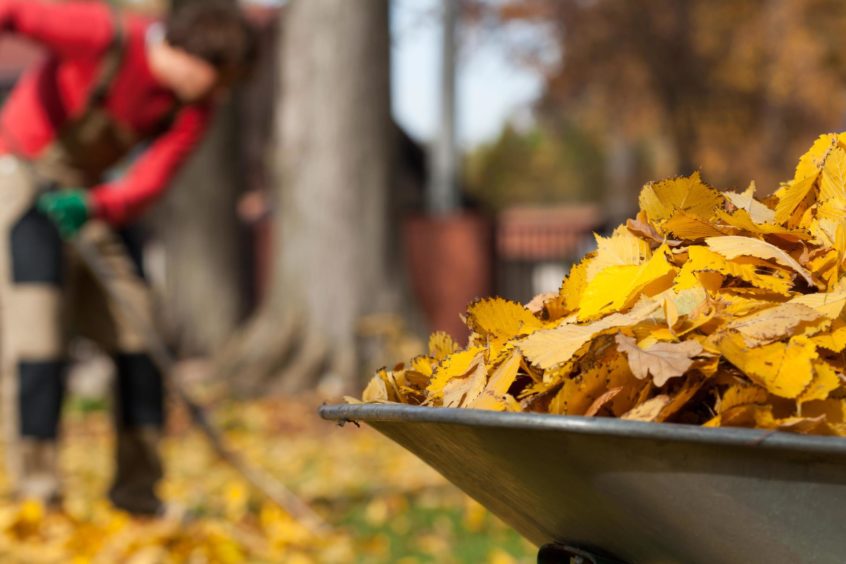After a frantic and energetic summer season in the garden, life moves at more gentler pace come autumn. It’s not time to put your feet up just yet as there’s still plenty to be getting on with but even the grass growth has slowed right down now so there’s definitely not the same rush.
Weather wise it’s been a cracking autumn too, so far. When it’s rained, it’s rained but on the whole we’ve had some nice dry and sunny days, perfect for getting out and enjoying walks in our public parks, gardens and beautiful countryside.
As you can imagine as someone responsible for a Victorian Pinetum of conifers towering over 40 metres tall, I’m not a fan of strong winds. Sadly, even a gentle breeze at this time of year can bring a premature end to one of my autumn highlights.
The south walls where I work are clothed with the most wonderful Boston Ivy climber, the three-lobed foliage turns the most stunning red colour. Unfortunately these 20 metre high walls are not afforded any wind protection and always seems to be the case that just when the display is at it’s peak, along comes the winds and blows all the leaves to the ground.
Although this vigorous climber is a favourite of mine it is not for the gardener who wants an easy life, its growth needing kept in check annually or would soon take over the house. This is a job I like carrying out late summer, the lines of the pruning cuts around the doors and windows looking crisp and sharp in time for this colourful display.
These fallen leaves will be the first of thousands to be tidied up from around the grounds over the coming weeks. Instead of stuffing them in to bin bags destined for land fill, we create a large heap in a shaded corner that will in a few years time, have decomposed down to the most wonderful garden compost. Creating a simple bin of posts and chicken wire for your own leaves is something you can easily do in your own garden at home.
Oh, when I was a lad, we would spend most of the winter raking and lifting piles of leaves by hand but without doubt the best method we use today for tidying up leaves is to hoover them up with the lawn mower. This isn’t us being lazy, the cutting action of the mower chops up and shreds the leaves in to smaller pieces, speeding up the time it takes for the leaves to break down into compost.
Not every garden has the room for numerous heaps so there’s no harm adding to your general garden waste compost heap, which at this time of year will enjoy being fed by a variety of ingredients – kitchen waste (though not from cooked food), dead herbaceous foliage and if you have a fire in the home, the wood ash after you’ve cleaned it out, potash being the element that helps our plants to flower and fruit.
A perfect job for warming you up on a colder autumn morning is ‘turning’ your compost heap.
As well as a nice bit of exercise, you’re mixing all these ingredients together incorporating air into the heap which is essential for the composting process to happen.
The waste from the maintenance I’m carrying out on my lawns at this time of year also gets added to my compost heap. This job always takes me back to my apprentice days, one of the jobs where the whole team worked together enjoying the banter as we cracked on.
The process starts off by scarifying, effectively raking out the moss and dead material which inhibits grass growth. The next job then is to aerate your lawn which lets oxygen down to the roots of the plant, essential to ensure good, healthy and strong grass growth.
This can be done by using a garden fork to spike the lawn a good 6 inches deep or every three years, like we used to on the bowling green, use a special tool called a hollow tine to remove thin plugs of soil.
A bit more work involved here as all these plugs need swept up, then a lawn specific top dressing mix brushed back into the holes. Either method perfect for improving the drainage on compacted patches in your own garden.
Back in the day (I’m only talking the 90’s!) we would have done these works early autumn but nowadays you’ve just enough time left if needing to do some lawn improvements.
Working on the soil
It gets trickier as we progress further into winter and autumn but choose drier spells for jobs requiring you working on the soil. If you have to, then work off planks of wood placed on the ground, spreading your weight more evenly to avoid adding to any compaction problems.
If any of those jobs aren’t enough for you to be getting on with this weekend then believe it or not a trip to your local garden centre could SAVE you some money.
As well as buying some nice ivy, cyclamen and heather to add a bit of seasonal colour to my tubs, the other day I also managed to pick put two climbing roses for my new archway, HALF PRICE!
Happy days!












